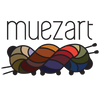Needles and Threads
 Embroidery isn't a concept that is very new for us, right?
Embroidery isn't a concept that is very new for us, right?
Well, if you are hunting for the best embroidery threads, needles and are looking for hand embroidery threads, this is the right blog for you!
What is Embroidery?
An embroidery is an art form of decorating fabric in unique ways, using a needle to apply thread or yarn.
Contemporary embroidery patterns are usually seen on caps, hats, coats, blankets, dress shirts, denim, dresses, stockings, and golf shirts. Hand embroidery is available with a wide variety of thread or yarn colors.
Wish to know about Eri silk embroidery threads?
Eri silk custom embroidery threads are hand-dyed, which are tightly twisted. They have a beautiful texture and behave like Perle cotton.
Each embroidery thread is 2-ply, because of which your projects are bound to have a textured effect!
Also, in Muezart, the embroidery thread spools are made of 100% bamboo.
Super sustainable!
How to start embroidery?
Guys, embroidery isn't rocket science, and it shouldn't feel like it's draining all the energy out of you.
It is a relatively easy and affordable hobby to adopt!
Once you thread your needle, you can gain more knowledge about the art of embroidery.
You can also pick up special tips, tools, and techniques that will improve or enhance your embroidery stitches.
But first, let me tell you what you'll need to start an embroidery stitch!
· The Right fabric
· Embroidery floss
· Embroidery hoops
· Embroidery Needles
· Scissors
Embroidery for Beginners
Learning hand embroidery is utterly fun and relaxing at the same time! Imagine creating beautiful art pieces with multicolored threads, followed by a needle.
Well, all good things seem intimidating at first, but once you get your hands and brain dirty, there is no turning back!
Here are some of the basic hand embroidery stitches that you need to know while you begin embroidery-
1. Backstitch
This embroidery stitch is the most likely to be used mainly. Backstitch is used for any outlining, and it also pairs well with other stitches, making it a pivotal stitch to learn.
2. Running Stitch
Great for making dashed outlines and detailed embroidery patterns for your embroidery project, this basic hand embroidery stitch is also the basis for Japanese sashiko embroidery.
It is pretty quickly adaptable but needs rigorous practice! For example, you can change the look by adjusting the length and spacing or adding a second row of stitches between the first. Running embroidery stitch also works well with weaving and wrapping.
3. Straight Stitch
The straight embroidery stitch is usually self-explanatory because it is as simple as bringing the needle up through the fabric and then going back down. This simple embroidery stitch can form designs like stars, scattered fills, and many other embroidery patterns.
Practice length and placement so you can work this versatile Stitch into your work
4. French Knot
This embroidery stitch tends to be challenging for some. While it may take time to learn, it's worth the effort.
The French knot embroidery pattern is a standard stitch to find in embroidery, but it is also a good stitch to use for making a textured fill or other design elements.
This Stitch involves wrapping the needle to form a knot on the surface of the fabric. The trick for making French knots is to hold the working thread not too tight. And like the other hand embroidery pattern stitches, this one demands practice too.
5. Stem Stitch
The stem hand embroidery stitch is another basic stitch that is great for creating smooth outlines.
This hand embroidery stitch works well for both straight lines and curves, and hence it is a versatile form of an embroidery pattern- which can be used on just about any bar in your stitching.
Like the other embroidery stitches, its width can be adjusted and used for fill stitching. But the length of this hand embroidery stitch has to be consistent to create a beautiful embroidery fabric.
Likewise, many hand embroidery stitches can be used to create unique embroidery designs.
And you know what? Once you get your hands dirty with Eri silk embroidery threads, you will fall in love with the art of embroidery.
How to end an Embroidery Stitch?
 Once you are done with your embroidery stitching, your embroidery design project may need to be rinsed or soaked to remove marks or any cringes.
Once you are done with your embroidery stitching, your embroidery design project may need to be rinsed or soaked to remove marks or any cringes.
When it comes out of the water, gently press away excess water with a towel. Then place the embroidery on a folded towel and press from the back with an iron. Muezart offers 100% sustainable Eri silk yarns and fibers and embroidery threads made in 100% natural ways.
Our Eri silk Embroidery thread combo is hand-dyed using 100% plant-based ingredients and minerals. This beautiful hand-dyed and natural embroidery threads are S-twisted and work great on rustic middleweight or light, thin fabric.
And as mentioned earlier, embroidery thread spools are made from bamboo and are naturally processed.
It is never too late to start something new, and I am sure this blog has helped you to know and understand the beauty of the art of embroidery.
So, get your hands onto our 100% natural and beautiful Eri silk embroidery threads!
Click here to check out our embroidery collection.

















Leave a comment